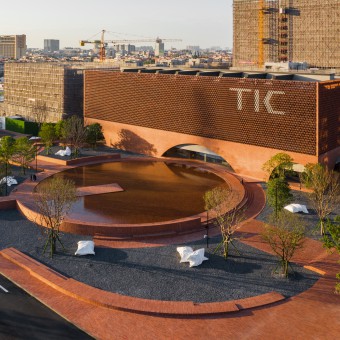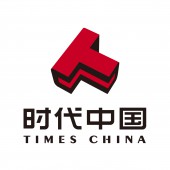Tic Art Exhibition Center by Ann Yu |
Home > Winners > #149026 |
 |
|
||||
| DESIGN DETAILS | |||||
| DESIGN NAME: Tic Art PRIMARY FUNCTION: Exhibition Center INSPIRATION: From north to south in China, the color of claybricks usedinfolkhousesgene UNIQUE PROPERTIES / PROJECT DESCRIPTION: TIC Art Center is a public urban landmark project.The overall design scope of covered landscape, architecture, interior, and products, bringing together the innovation of structure , aiming to provide a comprehensive yet rhythmic spatial experience .This project Influence as a micro urban landscape.It also Impact re-active the product trend of hand-made brick industry that makes a successful practice of environmental-friend OPERATION / FLOW / INTERACTION: The viewing platform stretching to the middle of the pool provides a panorama of the main facade of the building. The mesh-like double-layer curtain wall system is both the visual highlight and the technical focus of the project. A unique grid masonry effect is achieved by combining traditional ‘ceramic bricks’ with modern curtain wall structural design. Equilateral triangular modules are assembled to form the mesh-pattern facade. Thanks to the concealed anti-dropping nodes of the curtain wall, the unique aesthetics of the openwork masonry is ensured, and meanwhile, damage and falling of the ceramic panels are avoided. Through industrialized production, precision of the concealed aluminum alloy unit adopted for the ceramic mesh curtain wall is effectively ensured, whilst significantly improving the efficiency of its installation. The inner-layer curtain wall adopts ultra-clear glass in its conventional economical size. Single glass pieces with a length of 2,200mm enlarge the view from indoors and ensure fast installation. Thickened and laminated glass ribs avoid exposed frames, and the reduced width of glass ribs increases the utilization of interior space. This structure emphasizes the transparency and invisibility of the glass curtain wall, creating a clearer background for the outer mesh curtain wall formed by triangular ceramic bricks. A ‘valley’ passageway is constructed in the middle of the architecture. It created a highly through and interactive cavity within the building while separating the main displaying building volume from the operational annexe, it releases an uninterrupted touring experience within the main building. Therefore, multiple functions and flexible alteration of the building would be possible through its life cycle. It is either art piece or furniture. the harmonious integration of interior space and architecture is realized, a visual focus is to create rich spatial and sensory experiences for visitors. PROJECT DURATION AND LOCATION: The project started in October 2019 in Foshan and finished in October 2021 in Foshan, and was exhibited in October 2021. FITS BEST INTO CATEGORY: Architecture, Building and Structure Design |
PRODUCTION / REALIZATION TECHNOLOGY: The red bricks used through out architecture and landscape werecreated by 25 sets of molds,resulting in a continuous ambience in the project. The unify material selection was based on the local clay brick production tradition, and achieved a lower overall construction cost, as well as efficiency. The red bricks used in TIC Art Center were created by 25 sets of molds, resulting in rich specifications and trimming systems. The scale and proportion of the bricks were modernized in relation to the specifications of ‘hand-holdable bricks’, through iterative research on the six indicators, i.e. controllable furnace condition, material performance, applicable structure, process stability, production cost. Thus, the bricks were eventually refined. SPECIFICATIONS / TECHNICAL PROPERTIES: Landscape area:16000㎡,Bu TAGS: Art Center,Integrated Design,Exhibition Center,Handmade Bricks RESEARCH ABSTRACT: Since 2020, Chinese government has tightened macro control of the real estate sector, and the policy of rating real estate firms into four classes based on three key indicators signifies that the period of demographic, land and financial dividend is coming to the end. This has caused anxiety in the land market, and real estate developers in the private sector are taking a wait-and-see attitude. The game rules in the real estate market are evolving. In September 2021,TIC, alandmark urban maker town developed byTimes China, was unveiled to the public. In the same month, to the amazement of citizens of Foshan(located to the Southwest of Guangzhou and within its one-hour life circle), TIC Art Center was completed. Covering aplotarea of 3,000 mu (2 million square meters) and with a gross floorarea of 5 million square meters, the maker town complex, TIC, has turned against the tide in the turbulent real estate market. It has not only secured a leading position for Times China in real estate development in the center of Qiandeng Lake Area, Foshan, but has also become a new hot spot for local citizens. TIC Art Center, as an iconic symbol that represents the image ofthemakertown, received a total investment of around 180 million yuan.DOMANI was invited to carry out the overall design of the project, with the design scope covering landscape, architecture, interior,products, and more. Meanwhile, top-tier resources in the sectorare joined together to create a top-classworkwith high integrity, highstandards, high academic and commercial value and high urbanity, which is rarely seen in the real estate industryin recent years. The project becomes a hit, indicating that Times China is embarking on a new journey of refined product-oriented long-termdevelopment CHALLENGE: The overall passive design of the building minimizes energy consumption through the double-layer curtain wall system (clay brick grid + cavity + insulated low-e tempered glass) on the east, south and west facades. Compared with conventional curtain walls, the system reduces the heat conduction of the building by about 30% and estimated cooling energy consumption by 30%, effectively improving its insulation performance. At the same time, the 240mm-thick side openwork brick curtain wall system forms a sunlight filter, preventing glares caused by direct sunlight while enhancing the softness of the light through refraction. An arch with a maximum span of 29 meters is created on the facade wall. The top of the arch is composed of cantilever beams and upturned overhanging folding slabs so that it's higher than the beams between floors. The middle of the arch features cantilever beams and hanging columns and beams to achieve a wide scale. Finally, the non-arch section is build by cantilever beams and brick walls. The reception areaon the first floor emphasizes a transparentboundaryb ADDED DATE: 2023-02-23 06:58:04 TEAM MEMBERS (1) : IMAGE CREDITS: Ann Yu, 2022. |
||||
| Visit the following page to learn more: http://www.hkdomani.com/ | |||||
| AWARD DETAILS | |
 |
Tic Art Exhibition Center by Ann Yu is Winner in Architecture, Building and Structure Design Category, 2022 - 2023.· Press Members: Login or Register to request an exclusive interview with Ann Yu. · Click here to register inorder to view the profile and other works by Ann Yu. |
| SOCIAL |
| + Add to Likes / Favorites | Send to My Email | Comment | Testimonials | View Press-Release | Press Kit |







